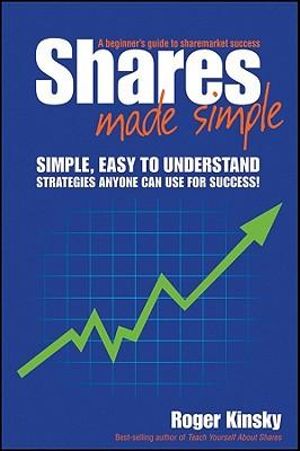Book Review – Shares Made Simple by Roger Kinsky

Roger Kinsky has written several books on share investing in Australia, apart from this book he has also written “Online Investing on the Australian Sharemarket” and “Teach Yourself About Shares” and several others. He has over 30 years’ experience in trading shares, he is an ideal teacher for someone who is starting out investing and is interested at looking into the share market. This book is a great starting point as Roger can provide a wealth of knowledge from his own experience which he is able to pass on through this book.
The scope of this book is as follows:
“If you’d like to invest successfully in shares without relying on the expertise of others and you don’t want to spend lots of time on research or management of a share portfolio, then this book is for you. My aim is to show you how you can make a success of share investing in the simplest and least time-consuming way possible.”
After reading the book I feel it matched the scope perfectly, the strategies provided in the novel would allow you to manage a portfolio with minor setting up time and minimal ongoing time necessary to keep it going.
I regret not reading this book earlier, when I first started investing in ETFs (around April 2020), I knew very little about shares and the stock market. I jumped right into the deep end and did not really understand much about what I was doing. In the end, by more luck than good management, it turned out alright for me. I do wish however that I read books like this one that could give me a foundation to be able to analyse and assess shares to determine their fundamental basis.
Although the book is targeted at beginners, I feel by the end of reading it you are still equipped with enough knowledge to be able to successfully invest within the share market. This might speak to how relatively simple investing in shares actually is, but I also believe it is due a fair amount to the writing style of Roger who is concise and efficient with his wording, and able to get through vast amounts of information in a relatively short space.
There are some significant limitations with this book however, and there are two main ones:
- It only deals with Australian shares
- It does not talk about ETFs
There are some other further limitations with the book, as it does not talk about the more “exotic” forms of share investments, like CFD, options, short selling, all those sorts of things which I do not know too much about personally. But like I said earlier, this is a book targeted to inexperienced investors so I did not have an issue with it not talking about these forms of share investment.
I can also understand why the author decided to only talk about investing in Australia as well, given it is targeted to beginners and Australians, it does make sense when you are starting out to make it as simple as possible. Investing in other countries will bring in a lot of risk that is more difficult to manage compared with investing in Australia. That being said however, it is definitely a significant limitation if you are trying to achieve geographic diversity in your share portfolio.
The bigger issue I had with this book is it did not mention ETFs at all. The book was written in 2010, so maybe they did not quite have the prominence within the investing world that they do have now. The oldest Australian based ETF (as far as I am aware) is SPDR S&P/ASX 200 Fund – SPW.AX. This fund only started 1st January 2008. At the time of writing this book, it would have been relatively new and definitely not as commonplace as it is now.
I would be interested if Roger Kinsky did decide to update this book, or write a new one, if he did incorporate ETFs or Index Fund investing into it. There was a whole chapter on diversifying a portfolio in this book, so I imagine that diversifying across the whole ASX200 would be a recommendation he might provide. He did write his book “Teach Yourself About Shares” in 2020, so I might need to give this book a read as well to see what it includes.
The biggest thing I got out of this book was a greater understanding of the ratios and data that is provided when analysing shares. There seems to be an endless amount of data provided with every listing on the ASX, and at times it can become overwhelming, especially when you do not know what you need to be looking for to determine if a share is performing well or not. This book went through the author’s pick for which criteria he believes are the most important when analysing shares. The criteria he provides definitely makes sense and it makes the whole process of analysing shares significantly easier. In this POST, I went through the ASX200 at the time of writing (15/5/2021) and, using his criteria, selected shares which met the author’s criteria and would be deemed as having strong fundamentals.
In summary, I really enjoyed this book. It flowed well, was easy to read and if you are a beginner looking to invest in shares it is a good place to start to build yourself a foundation. Like I have talked about, it is rather specific in what it does include in its content, and I believe there is some useful information that has been left out, but I believe that was done on purpose to keep this book true to the original scope.